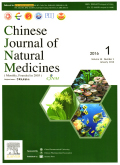Differences in anti-inflammatory effects between two specifications of Scutellariae Radix in LPS-induced macrophages in vitro
基本信息来源于合作网站,原文需代理用户跳转至来源网站获取
摘要:
Scutellariae Radix (SR),the root ofScutellaria baicalensis Georgi,is used as an antipyretic drug and has been demonstrated to have anti-inflammatory activity.SR is divided into two specifications,"Ku Qin" (KQ) and "Zi Qin" (ZQ),for use against different symptoms (upper energizer heat or lower portion of the triple energizer),according to the theory of traditional Chinese medicine (TCM).However,differences in the efficacies of these two specifications have not been determined.In the present study,we aimed to characterize the differences in the anti-inflammatory activities between KQ and ZQ and to explore how their differences are manifested in lipopolysaccharide (LPS)-induced macrophages.Our results showed that,in RAW264.7 cells (a mouse macrophage cell line derived from ascites),KQ and ZQ displayed anti-inflammatory effects by inhibiting the release of nitric oxide (NO),inducible NOS (iNOS),and nuclear factor-κB (NF-κB) in a dose-dependent manner without distinction.In NR8383 cells (a rat alveolar macrophage cell line),KQ and ZQ displayed similar effects on NO,iNOS,and NF-κB as seen in RAW264.7 cells,but KQ showed a higher inhibition rate for NO and iNOS than that shown by ZQ at the same concentration.These results indicated that there were differences in efficacy between KQ and ZQ in treating lung inflammation.Our findings provided an experimental evidence supporting the different uses of KQ and ZQ in clinic,as noted in ancient herbal records.

推荐文章
期刊_丙丁烷TDLAS测量系统的吸收峰自动检测
带间级联激光器
调谐半导体激光吸收光谱
雾剂检漏 中红外吸收峰 洛伦兹光谱线型
不同盐度、温度及光照对漂浮浒苔生理生态的影响
浒苔
盐度
温度
光照
生理生态
期刊_联合空间信息的改进低秩稀疏矩阵分解的高光谱异常目标检测
高光谱图像
异常目标检测 低秩稀疏矩阵分解 稀疏矩阵 残差矩阵
内容分析
关键词云
关键词热度
相关文献总数
(/次)
(/年)
引文网络
引文网络
二级参考文献 (28)
共引文献 (42)
参考文献 (15)
节点文献
引证文献 (0)
同被引文献 (0)
二级引证文献 (0)
1978(1)
- 参考文献(1)
- 二级参考文献(0)
1982(1)
- 参考文献(0)
- 二级参考文献(1)
1989(1)
- 参考文献(1)
- 二级参考文献(0)
1996(1)
- 参考文献(1)
- 二级参考文献(0)
1997(2)
- 参考文献(0)
- 二级参考文献(2)
1998(1)
- 参考文献(0)
- 二级参考文献(1)
2000(2)
- 参考文献(0)
- 二级参考文献(2)
2001(3)
- 参考文献(1)
- 二级参考文献(2)
2002(3)
- 参考文献(1)
- 二级参考文献(2)
2003(2)
- 参考文献(1)
- 二级参考文献(1)
2004(2)
- 参考文献(1)
- 二级参考文献(1)
2005(2)
- 参考文献(0)
- 二级参考文献(2)
2006(1)
- 参考文献(0)
- 二级参考文献(1)
2007(2)
- 参考文献(0)
- 二级参考文献(2)
2008(2)
- 参考文献(0)
- 二级参考文献(2)
2009(8)
- 参考文献(1)
- 二级参考文献(7)
2010(1)
- 参考文献(0)
- 二级参考文献(1)
2011(3)
- 参考文献(2)
- 二级参考文献(1)
2012(3)
- 参考文献(3)
- 二级参考文献(0)
2014(1)
- 参考文献(1)
- 二级参考文献(0)
2015(1)
- 参考文献(1)
- 二级参考文献(0)
2017(0)
- 参考文献(0)
- 二级参考文献(0)
- 引证文献(0)
- 二级引证文献(0)
引文网络交叉学科
相关学者/机构
期刊影响力
中国天然药物
主办单位:
中国药科大学
中国药学会
出版周期:
双月刊
ISSN:
2095-6975
CN:
32-1845/R
开本:
出版地:
南京童家巷24号
邮发代号:
创刊时间:
语种:
eng
出版文献量(篇)
1985
总下载数(次)
4
总被引数(次)
21556
期刊文献
相关文献
推荐文献
- 期刊分类
- 期刊(年)
- 期刊(期)
- 期刊推荐
中国天然药物2022
中国天然药物2021
中国天然药物2020
中国天然药物2019
中国天然药物2018
中国天然药物2017
中国天然药物2016
中国天然药物2015
中国天然药物2014
中国天然药物2013
中国天然药物2012
中国天然药物2011
中国天然药物2010
中国天然药物2009
中国天然药物2008
中国天然药物2007
中国天然药物2006
中国天然药物2005
中国天然药物2004
中国天然药物2003
中国天然药物2017年第9期
中国天然药物2017年第8期
中国天然药物2017年第7期
中国天然药物2017年第6期
中国天然药物2017年第5期
中国天然药物2017年第4期
中国天然药物2017年第3期
中国天然药物2017年第2期
中国天然药物2017年第12期
中国天然药物2017年第11期
中国天然药物2017年第10期
中国天然药物2017年第1期

 免费查重
免费查重










